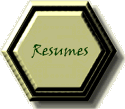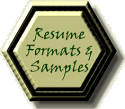What Are Your Job Skills?

Resume Content, Step One
Experience
Before you put together your resume, you will need to put together the content for it. List out all of the following:
|
|
Work Experience (ALL of it!) |
|
|
Volunteer Experience ( including professional, civic, community & hobby groups) |
|
|
Military Service & Training |
|
|
Education |
|
|
Other Training, Licenses & Certification |
|
|
Additional Skills (foreign languages, music, patents, published articles, etc.) |
|
|
Awards, Honors & Recognition |
Now pull together a folder containing all of the above information, any certificates, portfolio work , etc. Include all of your references, any awards and commendations you have received. This is your master document from which you will create your resume. Creating a master resume which contains all of the dates and information in one place serves several purposes. One, you can use this document for reference when filling out applications. Two, it will make it easier to tailor your individual resumes to specific jobs. Three, it saves time later in the process, as all of the information is in one place.
Skills
For each item from your experience list, state the skills it took to accomplish that task. Try to list 6 to 12 skills for each item.
These skills will break down into three categories: skills specific to a job or occupation, personality traits and interpersonal skills, and transferable skills. Employers look for all three.
Job specific skills are those you will need in a specific position. They may include customer service skills for a customer service rep, sales and account management skills for a salesperson, and management skills for a manager. They also include technical skills.
Personality traits and interpersonal skills reflect attitudes and behavior and include reliability, tactfulness, diplomacy, patience, flexibility, relationship-building and team skills. Personality traits and interpersonal skills should be expressed on a resume through concrete examples of accomplishments that illustrate your proficiency in them.
Transferable skills, skills which are transferable to any industry or position, can be either specific or interpersonal skills, and are especially important if you are transferring industries or trying to change positions. Most skills are in some way transferable.
The above skills translate into the action verbs you will want use to start each of your resume bullet points (Refer to Action Verb List). Some action verbs are stronger than others; for instance, collaborated is stronger than worked with, created is stronger than made, and established is stronger than set up.
When you are finished, you will want to have a list of at least 20 accomplishments, if not more, expressed in terms of concrete results and beginning with a strong action verb. These will become your resume bullet points.
Once you have completed the process of listing your accomplishments, you will be ready to evaluate your career focus and your goals.
Problem∙Action∙Resolution
PARs (Problem∙Action∙Resolution) are a succinct way of formatting your accomplishments to convey your skills and abilities to the reader or listener.
This is the format you will want to use for the success stories you tell in an interview when discussing your accomplishments with an interviewer. This format also becomes the structural basis for the accomplishments stated on your resume.
Start with the problem or challenge which you or your organization were faced with. Now give the action you took to resolve this situation, overcome the challenge, or create a win-win solution. Finally, give the resolution or result of the action you took, expressed in terms of $, #, %, time saved, productivity increases, etc. On a resume, unlike the interview, the problem or challenge is often implied in the action statement.
Example:
Designed courses & trained employees to use SAP human resource information module. Result: 100% employee compliance with corporate SAP standards.






